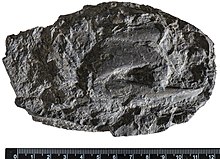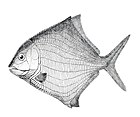| Nematoptychius Temporal range:
| |
|---|---|

| |
| fossil of Nematoptychius greenocki | |
| Scientific classification | |
| Kingdom: | |
| Phylum: | |
| Class: | |
| Order: | |
| Genus: | †Nematoptychius Traquair, 1875
|
| Binomial name | |
| †Nematoptychius greenocki (Traquair, 1866)
| |
| Type species | |
| †Pygopterus greenocki Traquair, 1866
| |
| Other species[1] | |
| |
Nematoptychius is an extinct genus of prehistoric bony fish that lived from the Visean age of the Mississippian epoch (Early Carboniferous) to the Bashkirian age of the Pennsylvanian epoch (Late Carboniferous) in what is now Scotland, Belgium and France.[3]
Its type species, Nematoptychius greenocki, was first described as Pygopterus greenocki by Ramsay Traquair.[1]
See also
[edit]References
[edit]- ^ a b c Schultze, Hans-Peter; Mickle, Kathryn E.; Poplin, Cecile; Hilton, Eric J.; Grande, Lance (2021). Handbook of Paleoichthyology, 8A. Actinopterygii I. Palaeoniscimorpha, Stem Neopterygii, Chondrostei. Dr. Friedrich Pfeil, München. p. 299. ISBN 978-3-89937-272-4.
- ^ "Palaeonisciformes". Paleobiology Database. Retrieved 19 Nov 2012.
- ^ Sepkoski, Jack (2002). "A compendium of fossil marine animal genera". Bulletins of American Paleontology. 364: 560. Retrieved 2009-04-24.








Well, that’s interesting to know that Psilotum nudum are known as whisk ferns. Psilotum nudum is the commoner species of the two. While the P. flaccidum is a rare species and is found in the tropical islands. Both the species are usually epiphytic in habit and grow upon tree ferns. These species may also be terrestrial and grow in humus or in the crevices of the rocks.
View the detailed Guide of Psilotum nudum: Detailed Study Of Psilotum Nudum (Whisk Fern), Classification, Anatomy, Reproduction